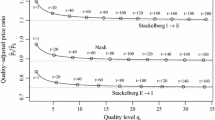This paper analyzes the growth effects of competition in a product-cycle model with innovation, imitation and non-diversifiable risk. Imitation leads to oligopolistic competition and innovation restores a monopoly in the market. In contrast to the models that assume diversifiable risk, this paper shows the following. Positive profits in the oligopoly stages of the product cycle are necessary for technological change. A little intensity of competition is growth diminishing. Only if the intensity of competition exceeds a critical level, its increase enhances growth.
Similar content being viewed by others
References
Aghion P and Howitt P (1998). Endogenous growth theory. MIT Press, Cambridge, MA
Aghion P, Harris C and Vickers J (1997). Competition and growth with step-by-step innovation: an example. Eur Econ Rev 41: 771–782
Aghion P, Harris C, Howitt P and Vickers J (2001). Competition, imitation and growth with step-by-step innovation. Rev Econ Stud 68: 467–492
Aghion P, Bloom N, Blundell R, Griffith R and Howitt P (2005). Competition and innovation: an inverted-U relationship. Q J Econ 120: 701–728
Cheng LK and Tao Z (1999). The impact of public policies on innovation and imitation: the role of R&D technology in growth models. Int Econ Rev 40: 187–207
Davidson C and Segerstrom P (1998). R&D subsidies and economic growth. RAND J Econ 29: 548–577
Dixit A and Pindyck K (1994). Investment under uncertainty. Princeton University Press, Princeton
Ethier W (1982). National and international returns to scale in the modern theory of international trade. Am Econ Rev 71: 389–405
Gompers P and Lerner J (1999). The venture capital cycle. The MIT Press, Cambridge, MA
Grossman G and Helpman E (1991). Innovation and growth. The MIT Press, Cambridge, MA
Horii R and Iwaisako T (2007). Economic growth with imperfect protection of intellectual property rights. J Econ 90: 45–85
Mukoyama T (2003). Innovation, imitation and growth with cumulative technology. J Monet Econ 50: 361–380
Segerstrom PS (1991). Innovation, imitation and economic growth. J Polit Econ 99: 807–827
Segerstrom PS and Zolnierek JM (1999). The R&D incentives of industry leaders. Int Econ Rev 40: 745–766
Tang JG and Wälde K (2001). International competition, growth and welfare. Eur Econ Rev 45: 1439–1459
Wälde K (1999a). A model of creative destruction with undiversifiable risk and optimizing households. Econ J 109: C156–C171
Wälde K (1999b). Optimal saving under Poisson uncertainty. J Econ Theory 87: 194–217
Author information
Authors and Affiliations
Corresponding author
Rights and permissions
About this article
Cite this article
Palokangas, T. Competition and product cycles with non-diversifiable risk. J Econ 94, 1–30 (2008). https://doi.org/10.1007/s00712-007-0305-z
Received:
Accepted:
Published:
Issue Date:
DOI: https://doi.org/10.1007/s00712-007-0305-z




